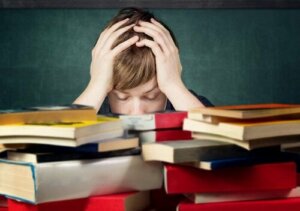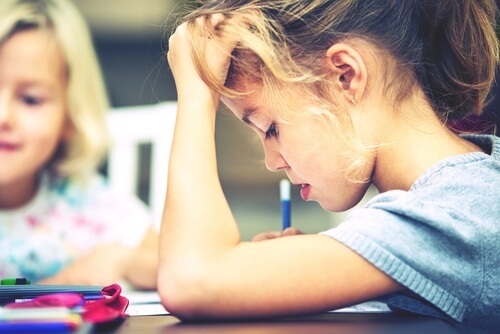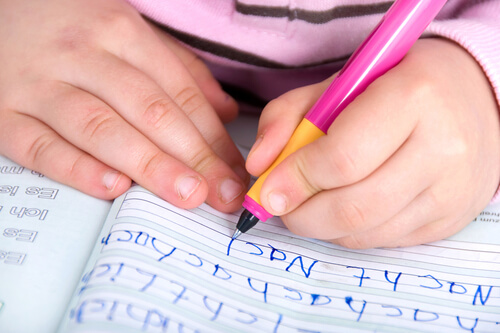How Dyslexia and Dysgraphia Affect Children

Dyslexia and dysgraphia are among the specific disorders of the development of school skills. The first affects the reading process, while the second causes difficulty with written expression. But there’s no need to worry, as your child can overcome the aspects that can affect them.
Reading practice, different psychopedagogical texts explain, has a decisive and general influence on language skills. Reading favors the acquisition of vocabulary and speeds up verbal reasoning. This is why dyslexia generates opposite effects.
Dyslexia can affect more than reading because it can also cause difficulties with writing, speaking, math, and social skills.
For this reason, and especially at school age, some children with this disorder lack self-confidence. This is because they tend to feel that they’re different from other children and worry about being intelligent or not.
However, scientific studies, including those published in the journal Enfoques Educativos, affirm that dyslexia is a specific difficulty, independent of intelligence. Therefore, a child can be dyslexic whether they’re very smart or not. The dyslexia category only identifies a lack of reading ability.
To improve your child’s self-confidence, you can encourage them to choose activities that strengthen their abilities. They could practice these activities after school. If they do well in an area, this can help them build their self-confidence and self-esteem.
As Mark Griffin, founder and director of Eagle Hill School, explains in an article, experts have found that many people with dyslexia have difficulty distinguishing or separating sounds in spoken words. Some children have trouble pronouncing unfamiliar words aloud.
Griffin says it’s not uncommon for kids to have dyslexia and dysgraphia at the same time.

Handwriting
Children with dysgraphia may have trouble with handwriting, organizing their thoughts on paper, or both.
According to Adelfo Tapia Pavón “dysgraphia refers to individuals who confuse, omit, join and/or reverse syllables or letters incorrectly”. This condition also hinders the ability to understand expressions of language, such as sarcasm.
But to enjoy humor, sarcasm isn’t necessary, you can very well watch a movie or a program with your child that has easy-to-understand humor and direct language. Laugh together and enjoy, then you could talk about how funny the show was.
Keep in mind that writing can be a slow and difficult process for children with dysgraphia, so forcing them to do write can create anxiety.
You can help manage this situation by doing a journaling exercise or other activities that develop the habit of writing. Remember that every individual who is disadvantaged in something deserves help, understanding, and respect. This is enough, but many times, it’s not what they receive.

Skills that dysgraphia can affect
Fine motor control: Dysgraphia can affect the ability to coordinate small muscle movements of the fingers and other parts of the body.
This can make it difficult for them to do tasks like tying shoelaces, fastening buttons, and handling scissors.
They also have a hard time holding a pencil properly, fitting it comfortably in the hand, and writing without getting tired.
Visual processing: This condition hinders the ability to differentiate patterns, colors, and different shapes.
Children with this condition find it difficult to separate words, letters, shapes, and numbers.
They also find it difficult to write on or between the lines, draw numbers, letters, and shapes in appropriate proportion and size, as well as draw and read maps.
Planning and organization: In this regard, it’s difficult for them to organize their thoughts and organize them coherently, in writing.
Remembering key information and important details to write down, thinking of words to write, as well as using correct grammar and syntax while writing, are also challenging.
However, these skills can be taught with time, dedication, and the help of educational psychologists.
Dyslexia and dysgraphia are among the specific disorders of the development of school skills. The first affects the reading process, while the second causes difficulty with written expression. But there’s no need to worry, as your child can overcome the aspects that can affect them.
Reading practice, different psychopedagogical texts explain, has a decisive and general influence on language skills. Reading favors the acquisition of vocabulary and speeds up verbal reasoning. This is why dyslexia generates opposite effects.
Dyslexia can affect more than reading because it can also cause difficulties with writing, speaking, math, and social skills.
For this reason, and especially at school age, some children with this disorder lack self-confidence. This is because they tend to feel that they’re different from other children and worry about being intelligent or not.
However, scientific studies, including those published in the journal Enfoques Educativos, affirm that dyslexia is a specific difficulty, independent of intelligence. Therefore, a child can be dyslexic whether they’re very smart or not. The dyslexia category only identifies a lack of reading ability.
To improve your child’s self-confidence, you can encourage them to choose activities that strengthen their abilities. They could practice these activities after school. If they do well in an area, this can help them build their self-confidence and self-esteem.
As Mark Griffin, founder and director of Eagle Hill School, explains in an article, experts have found that many people with dyslexia have difficulty distinguishing or separating sounds in spoken words. Some children have trouble pronouncing unfamiliar words aloud.
Griffin says it’s not uncommon for kids to have dyslexia and dysgraphia at the same time.

Handwriting
Children with dysgraphia may have trouble with handwriting, organizing their thoughts on paper, or both.
According to Adelfo Tapia Pavón “dysgraphia refers to individuals who confuse, omit, join and/or reverse syllables or letters incorrectly”. This condition also hinders the ability to understand expressions of language, such as sarcasm.
But to enjoy humor, sarcasm isn’t necessary, you can very well watch a movie or a program with your child that has easy-to-understand humor and direct language. Laugh together and enjoy, then you could talk about how funny the show was.
Keep in mind that writing can be a slow and difficult process for children with dysgraphia, so forcing them to do write can create anxiety.
You can help manage this situation by doing a journaling exercise or other activities that develop the habit of writing. Remember that every individual who is disadvantaged in something deserves help, understanding, and respect. This is enough, but many times, it’s not what they receive.

Skills that dysgraphia can affect
Fine motor control: Dysgraphia can affect the ability to coordinate small muscle movements of the fingers and other parts of the body.
This can make it difficult for them to do tasks like tying shoelaces, fastening buttons, and handling scissors.
They also have a hard time holding a pencil properly, fitting it comfortably in the hand, and writing without getting tired.
Visual processing: This condition hinders the ability to differentiate patterns, colors, and different shapes.
Children with this condition find it difficult to separate words, letters, shapes, and numbers.
They also find it difficult to write on or between the lines, draw numbers, letters, and shapes in appropriate proportion and size, as well as draw and read maps.
Planning and organization: In this regard, it’s difficult for them to organize their thoughts and organize them coherently, in writing.
Remembering key information and important details to write down, thinking of words to write, as well as using correct grammar and syntax while writing, are also challenging.
However, these skills can be taught with time, dedication, and the help of educational psychologists.
All cited sources were thoroughly reviewed by our team to ensure their quality, reliability, currency, and validity. The bibliography of this article was considered reliable and of academic or scientific accuracy.
- Alvarado, H., Damians, M., Gómez, E., Martorell, N., Salas, A., & Sancho, S. (2007). Dislexia. Detección, diagnóstico e intervención interdisciplinar. Enginy.
- Aragón, L. E. (2001). Intervención con niños disléxicos: evaluación y tratamiento. México: Trillas. http://www.trillaseduforma.com/zona-prensa/ficheros/resenas/8466541675.pdf
- Artigas-Pallarés, J. (2002). Problemas asociados a la dislexia. Revista de Neurología, 34(1), 7-13. http://ardilladigital.com/DOCUMENTOS/EDUCACION%20ESPECIAL/LOGOPEDIA/TRASTORNOS%20LENGUAJE/DISLEXIAS/Problemas%20asociados%20a%20la%20dislexia%20-%20Artigas%20-%20art.pdf
- Tapia Pavón, A. La disgrafia. Libros Ambigú. España. Año 1990. ISBN 10: 8440461429 / ISBN 13: 9788440461421
- Mondragón Barrios, L. (2007). dislexia. Salud Mental.
- PRODISLEX. (2010). Protocolos de detección y actuación en dislexia. PRODISLEX.
- Anguis J, Esther L. Dislexia en edad escolar. Revista Enfoques Educativos. Número 29. Enero 2009. P 30-40. Disponible en: https://www.yumpu.com/es/document/read/47936006/revista-enfoques-educativos-na-29-enfoqueseducativoses
This text is provided for informational purposes only and does not replace consultation with a professional. If in doubt, consult your specialist.








